Watched August 6- 12, 2007: Ninagawa, (Kiyoshi) Kurosawa and Shiota
Sakuran (Mika Ninagawa, 2006)
 This film recounts the story of a high class prostitute (called an oiran) starting with her childhood (when she is sold to a brothel in the Yoshiwara district of Tokyo) through her rise to the top tier of her profession over the course of the next ten years or so.
This film recounts the story of a high class prostitute (called an oiran) starting with her childhood (when she is sold to a brothel in the Yoshiwara district of Tokyo) through her rise to the top tier of her profession over the course of the next ten years or so. 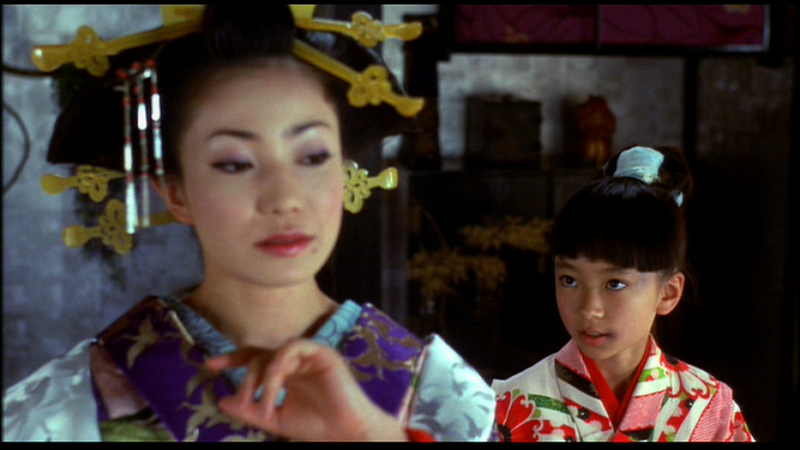 The time period is not specified, but the events here have to have taken place no later than the beginning of the 1700s (because by mid-century oiran had largely died out, having replaced by geisha). Our heroine (played as a young woman by Anna Tsuchiya) is reasonably engaging --
The time period is not specified, but the events here have to have taken place no later than the beginning of the 1700s (because by mid-century oiran had largely died out, having replaced by geisha). Our heroine (played as a young woman by Anna Tsuchiya) is reasonably engaging --  but the story (based on a manga by Moyoco Anno, wife of Evangelion director Hideko Anno) is more than a little problematic. First, there is a matter of authenticity, While not so spurious as the Hollywood confection Memoirs of a Geisha, it nonetheless presents a depiction that has only a tangential connection to historical reality. The highest level oiran apparently operated at a level of rarefied sophistication that would make the most polished geisha look somewhat coarse and unrefined in comparison --
but the story (based on a manga by Moyoco Anno, wife of Evangelion director Hideko Anno) is more than a little problematic. First, there is a matter of authenticity, While not so spurious as the Hollywood confection Memoirs of a Geisha, it nonetheless presents a depiction that has only a tangential connection to historical reality. The highest level oiran apparently operated at a level of rarefied sophistication that would make the most polished geisha look somewhat coarse and unrefined in comparison -- 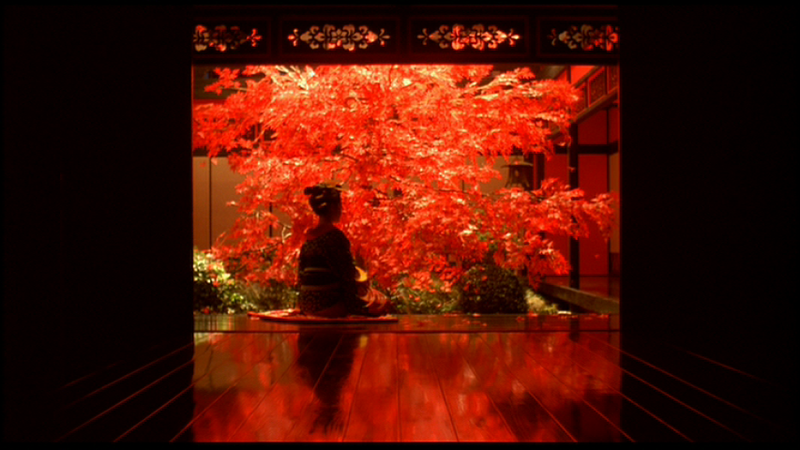 and the film completely misfires on this (except as to fanciness of the star's clothing). Possibly even worse, the film glamorizes (and trivializes) prostitution -- suggesting that neither the writer nor director has much familiarity with the real profession or with the remarkable catalog of Japanese films dealing far more honestly and intelligently with such issue.
and the film completely misfires on this (except as to fanciness of the star's clothing). Possibly even worse, the film glamorizes (and trivializes) prostitution -- suggesting that neither the writer nor director has much familiarity with the real profession or with the remarkable catalog of Japanese films dealing far more honestly and intelligently with such issue.
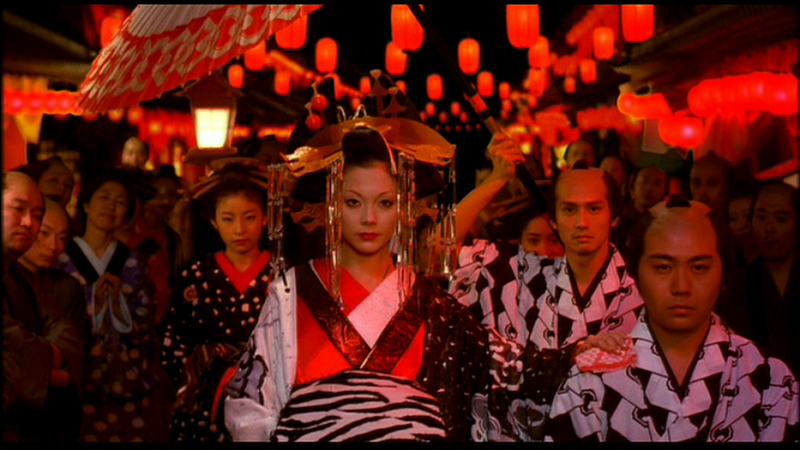 Looking at this film from a purely visual perspective, it is often gorgeous. Ninagawa may be a first-time director, but she is also a highly experienced still photographer (lots of fashion photography, among other things). Indeed, one could justifiably call much of the camera work here "fashion cinematography". The art direction is similarly gorgeous --
Looking at this film from a purely visual perspective, it is often gorgeous. Ninagawa may be a first-time director, but she is also a highly experienced still photographer (lots of fashion photography, among other things). Indeed, one could justifiably call much of the camera work here "fashion cinematography". The art direction is similarly gorgeous -- 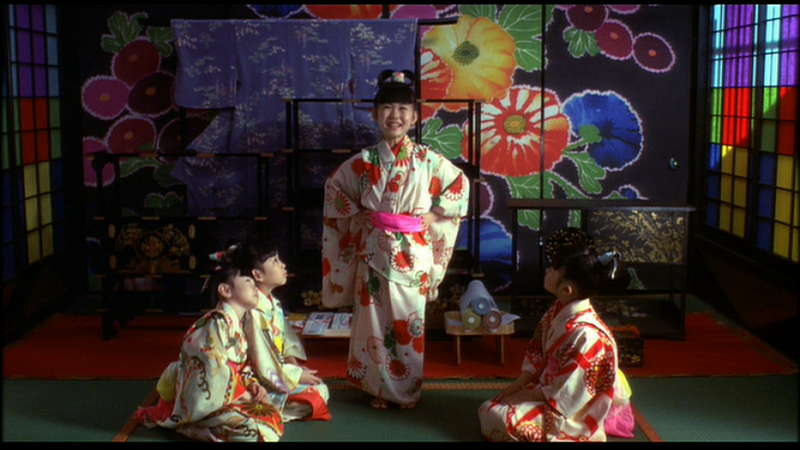 though its gaudiness makes ZHANG Yimou's Curse of the Golden Flower look positively drab and dowdy in comparison. The direction is generally passable -- but there are some significant lapses (such as at least one important character who does not age in tandem with our heroine). The plotting is often more than a little implausible (even aside from historical authenticity). The acting is generally decent, but rarely outstanding. If only the essentials of this film were as good as its accidentals...
though its gaudiness makes ZHANG Yimou's Curse of the Golden Flower look positively drab and dowdy in comparison. The direction is generally passable -- but there are some significant lapses (such as at least one important character who does not age in tandem with our heroine). The plotting is often more than a little implausible (even aside from historical authenticity). The acting is generally decent, but rarely outstanding. If only the essentials of this film were as good as its accidentals...
The Japanese DVD looks great -- and has good English subtitles on the film itself (but not the extras). More pictures (just because they are pretty):
http://i9.photobucket.com/albums/a59/mkerpan/aug_07/sakuran02.png
http://i9.photobucket.com/albums/a59/mkerpan/aug_07/sakuran03.png
http://i9.photobucket.com/albums/a59/mkerpan/aug_07/sakuran05.png
http://i9.photobucket.com/albums/a59/mkerpan/aug_07/sakuran06.png
http://i9.photobucket.com/albums/a59/mkerpan/aug_07/sakuran07.png
http://i9.photobucket.com/albums/a59/mkerpan/aug_07/sakuran11.png
http://i9.photobucket.com/albums/a59/mkerpan/aug_07/sakuran12.png
http://i9.photobucket.com/albums/a59/mkerpan/aug_07/sakuran13.png
http://i9.photobucket.com/albums/a59/mkerpan/aug_07/sakuran14.png
http://i9.photobucket.com/albums/a59/mkerpan/aug_07/sakuran16.png
http://i9.photobucket.com/albums/a59/mkerpan/aug_07/sakuran17.png
Sakebi / Retribution (Kiyoshi Kurosawa, 2006)
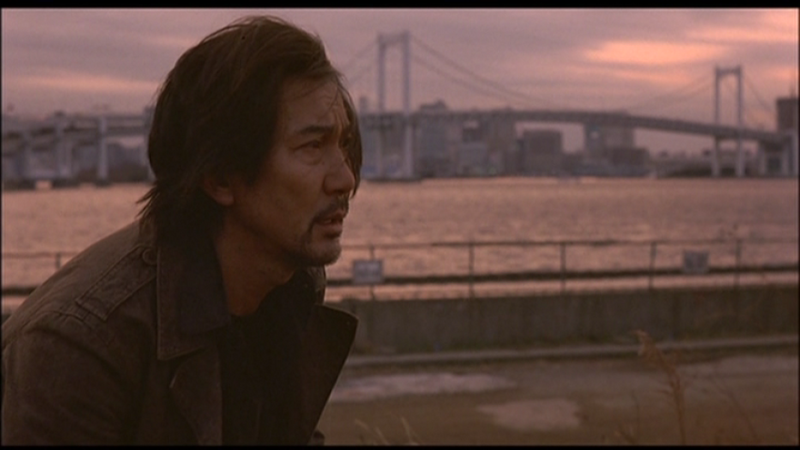 For some reason, I was sure that the Japanese release of Kurosawa's new film would have English subtitles -- but it didn't. while non-plussed initially, after I began my viewing of the film I began to wonder if the lack of subtitles didn't make following the film easier. I have long suspected that Kurosawa's films rely far more on some sort of "visual logic" than on anything resembling traditional "narrative logic" -- and Retribution may well support this theory.
For some reason, I was sure that the Japanese release of Kurosawa's new film would have English subtitles -- but it didn't. while non-plussed initially, after I began my viewing of the film I began to wonder if the lack of subtitles didn't make following the film easier. I have long suspected that Kurosawa's films rely far more on some sort of "visual logic" than on anything resembling traditional "narrative logic" -- and Retribution may well support this theory.
 Once again, in this film, Kurosawa assigns the central role to Koji Yakusho -- and once again Yakusho plays a police officer beset with problems. Here he is part of a team investigating a series of murders that have a number of common elements yet turn out to have totally unrelated perpetrators.
Once again, in this film, Kurosawa assigns the central role to Koji Yakusho -- and once again Yakusho plays a police officer beset with problems. Here he is part of a team investigating a series of murders that have a number of common elements yet turn out to have totally unrelated perpetrators.  Chief among the common elements -- the use of drowning to kill the victims and various apparent links back to Yakusho himself (that don't really fit with the rest of the crime scene evidence). There also seems to be lady ghost dressed in red, who is interested both in the crimes and in Yakusho himself.
Chief among the common elements -- the use of drowning to kill the victims and various apparent links back to Yakusho himself (that don't really fit with the rest of the crime scene evidence). There also seems to be lady ghost dressed in red, who is interested both in the crimes and in Yakusho himself.
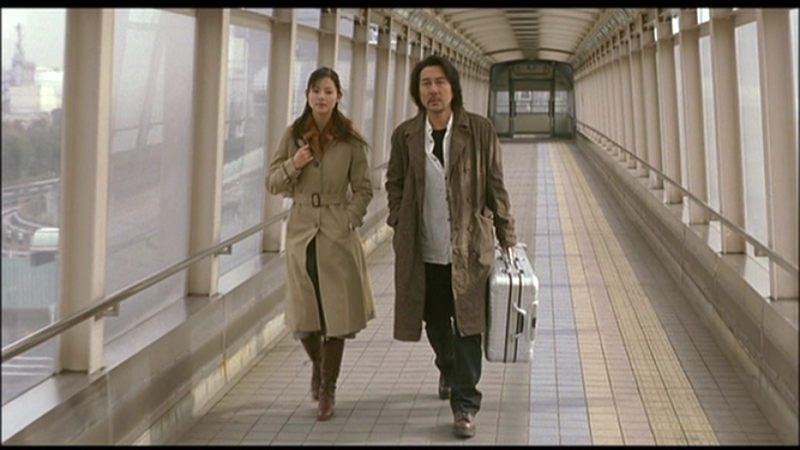 Yakusho is not the most suave police investigator one has seen -- and he shows a disturbing tendency to use violent methods towards suspects (which unsettles his colleagues more than a little). Despite his uncouthness, he has (or had) a rather sophisticated and sweet-natured girl -- but rather elusive -- girl friend.
Yakusho is not the most suave police investigator one has seen -- and he shows a disturbing tendency to use violent methods towards suspects (which unsettles his colleagues more than a little). Despite his uncouthness, he has (or had) a rather sophisticated and sweet-natured girl -- but rather elusive -- girl friend. 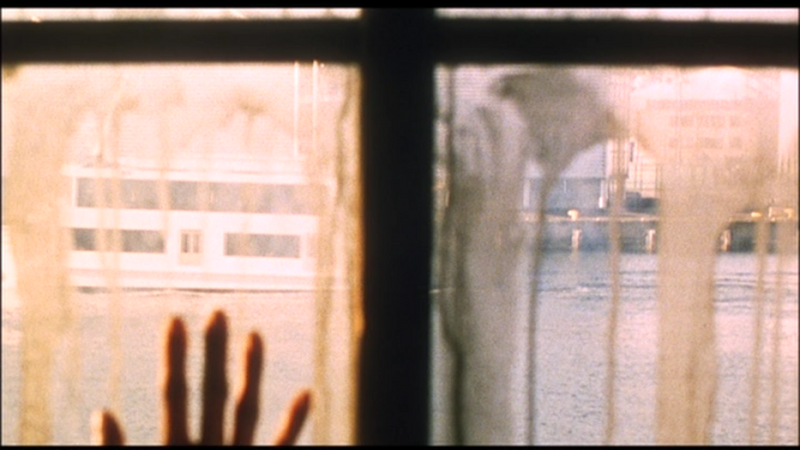 One never is certain as to just where the scenes of Yakusho and lady friend fit into the time sequence associated with the murder investigations. some clearly appear to be flashbacks -- while others seem to be contemporaneous (but are curiously disconnected from the main narrative). The film eventually deals with (but doesn't ever directly explain) why the murders occur -- and why Yakusho seems to be at the center of events.
One never is certain as to just where the scenes of Yakusho and lady friend fit into the time sequence associated with the murder investigations. some clearly appear to be flashbacks -- while others seem to be contemporaneous (but are curiously disconnected from the main narrative). The film eventually deals with (but doesn't ever directly explain) why the murders occur -- and why Yakusho seems to be at the center of events.
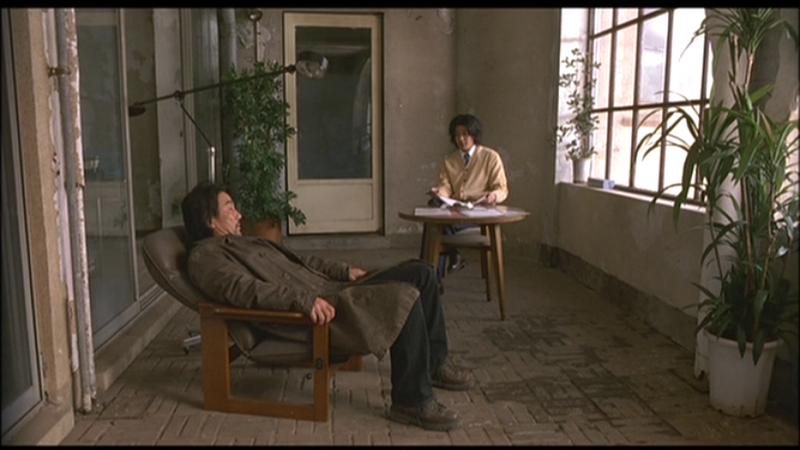 I found this one of Kurosawa's most impressive and enjoyable films to date. It is also pretty thoroughly enigmatic -- something that seems a virtue in the case of this director. This looks great visually (though often dark-ish) -- and Yakusho turns in another first-rate acting performance.
I found this one of Kurosawa's most impressive and enjoyable films to date. It is also pretty thoroughly enigmatic -- something that seems a virtue in the case of this director. This looks great visually (though often dark-ish) -- and Yakusho turns in another first-rate acting performance. 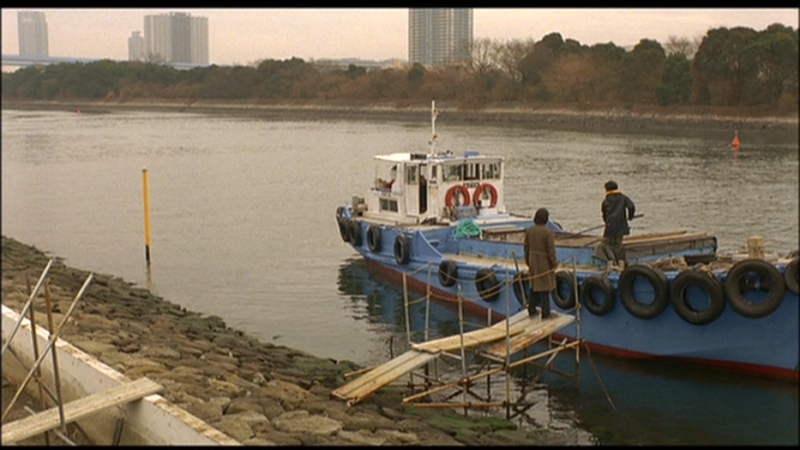 The Japanese DVD looks very good and has lots of (unsubbed) extras -- including what would appear to be an alternate ending (that sort of supports my tentative reading of the film). As it turns out, the Hong Kong DVD of this is already out -- and is both subtitled and cheaper than the Japanese version. I guess I am stuck with hoping my copy at least might look better (but one can never tell these days with Hong Kong releases).
The Japanese DVD looks very good and has lots of (unsubbed) extras -- including what would appear to be an alternate ending (that sort of supports my tentative reading of the film). As it turns out, the Hong Kong DVD of this is already out -- and is both subtitled and cheaper than the Japanese version. I guess I am stuck with hoping my copy at least might look better (but one can never tell these days with Hong Kong releases).
Dororo (Akihiko Shiota, 2007)
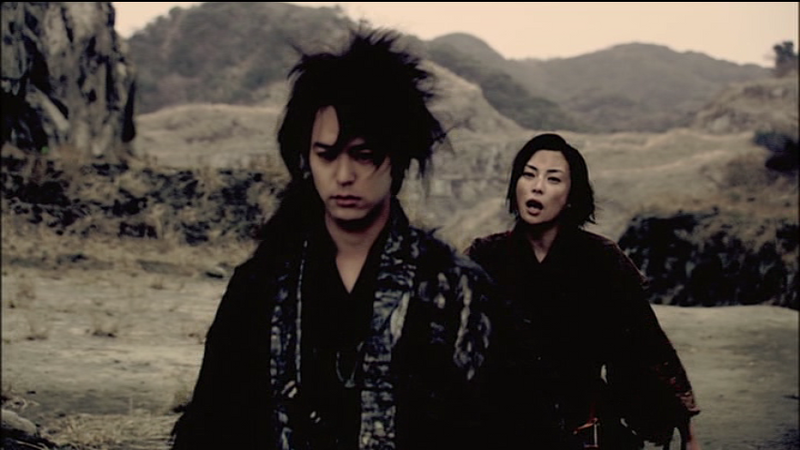 Another great looking new Japanese film based on a manga. The manga here, however, is a classic by the godfather of Japanese manga and anime, Osamu Tezuka. Tezuka's manga told of a ruthless warrior who traded in his soon-to-arrive first-born son for vastly improved warmaking powers, following a defeat in battle.
Another great looking new Japanese film based on a manga. The manga here, however, is a classic by the godfather of Japanese manga and anime, Osamu Tezuka. Tezuka's manga told of a ruthless warrior who traded in his soon-to-arrive first-born son for vastly improved warmaking powers, following a defeat in battle.  He makes this deal with a pack of (48) demons, each of whom is to get a bit of the son. When the son is born, there is little left but a husk -- which the father wants to destroy (but which mother floats down the river in a rush basket, a la Moses). Luckily for the infant, he is found by a healer-magician-scientist who sets about creating a full set of replacement parts --
He makes this deal with a pack of (48) demons, each of whom is to get a bit of the son. When the son is born, there is little left but a husk -- which the father wants to destroy (but which mother floats down the river in a rush basket, a la Moses). Luckily for the infant, he is found by a healer-magician-scientist who sets about creating a full set of replacement parts --  with some enhancements (such as blessed blades hidden inside his arms). When the child (now named Hyakkimaru or "hundred demons" -- and played by Tsumabuki Satoshi) reaches manhood (sort of), he sets off to reclaim his real missing parts. Along the way, he encounters a young orphaned thief (a girl masquerading as a boy, as protective coloration). This girl (played by Kou Shibasaki), named Dororo, sets off following Hyakkimaru.
with some enhancements (such as blessed blades hidden inside his arms). When the child (now named Hyakkimaru or "hundred demons" -- and played by Tsumabuki Satoshi) reaches manhood (sort of), he sets off to reclaim his real missing parts. Along the way, he encounters a young orphaned thief (a girl masquerading as a boy, as protective coloration). This girl (played by Kou Shibasaki), named Dororo, sets off following Hyakkimaru. 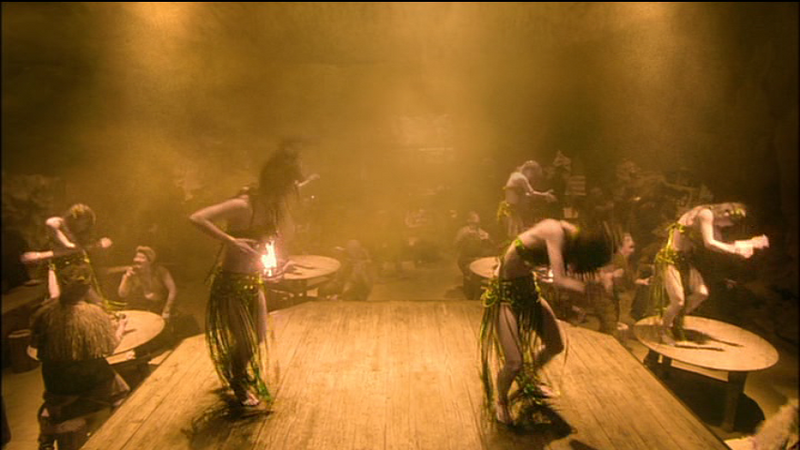 While she sometimes causes extra problems for him, she provides invaluable aid at other times. Their relationship comes under strain when she discovers that his real father was responsible for destroying her village (and her parents). Hyakkimaru eventually encounters his parents and younger brother -- an event that seems to displease his father mightily.
While she sometimes causes extra problems for him, she provides invaluable aid at other times. Their relationship comes under strain when she discovers that his real father was responsible for destroying her village (and her parents). Hyakkimaru eventually encounters his parents and younger brother -- an event that seems to displease his father mightily.
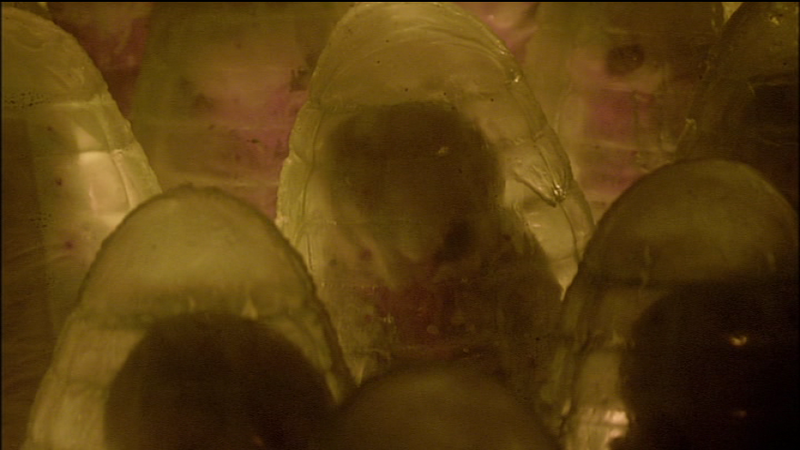 The film is marvelous looking -- and the special effects (good and bad) are lots of fun. One doesn't demand great acting from a cartoon -- but the leads and supporting performers are all pretty good here. The scenery (courtesy of New Zealand) is also pretty outstanding. I got the budget version of the unsubbed Japanese DVD, which supplied little in the way of extras.
The film is marvelous looking -- and the special effects (good and bad) are lots of fun. One doesn't demand great acting from a cartoon -- but the leads and supporting performers are all pretty good here. The scenery (courtesy of New Zealand) is also pretty outstanding. I got the budget version of the unsubbed Japanese DVD, which supplied little in the way of extras. 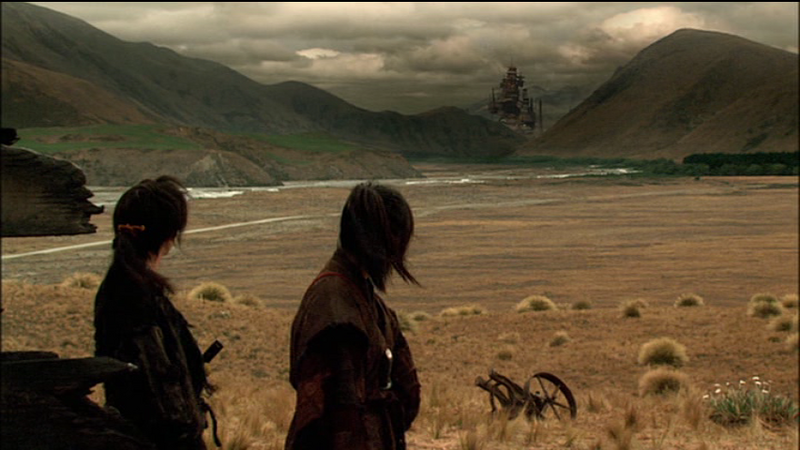 The visual storytelling here is so clear that subtitles are rarely needed (much) -- all one really needs in order to follow and enjoy the film is a little background information (which you now have). Not "great art", perhaps, but a very enjoyable film from a very fine director better known for more "serious "films.
The visual storytelling here is so clear that subtitles are rarely needed (much) -- all one really needs in order to follow and enjoy the film is a little background information (which you now have). Not "great art", perhaps, but a very enjoyable film from a very fine director better known for more "serious "films.
A few more screen shots:
http://i9.photobucket.com/albums/a59/mkerpan/shiota/dororo01.png
http://i9.photobucket.com/albums/a59/mkerpan/shiota/dororo02.png
http://i9.photobucket.com/albums/a59/mkerpan/shiota/dororo06.png
http://i9.photobucket.com/albums/a59/mkerpan/shiota/dororo07.png
http://i9.photobucket.com/albums/a59/mkerpan/shiota/dororo08.png
http://i9.photobucket.com/albums/a59/mkerpan/shiota/dororo10.png
http://i9.photobucket.com/albums/a59/mkerpan/shiota/dororo11.png
http://i9.photobucket.com/albums/a59/mkerpan/shiota/dororo13.png
http://i9.photobucket.com/albums/a59/mkerpan/shiota/dororo15.png
http://i9.photobucket.com/albums/a59/mkerpan/shiota/dororo16.png
http://i9.photobucket.com/albums/a59/mkerpan/shiota/dororo17.png
 This film recounts the story of a high class prostitute (called an oiran) starting with her childhood (when she is sold to a brothel in the Yoshiwara district of Tokyo) through her rise to the top tier of her profession over the course of the next ten years or so.
This film recounts the story of a high class prostitute (called an oiran) starting with her childhood (when she is sold to a brothel in the Yoshiwara district of Tokyo) through her rise to the top tier of her profession over the course of the next ten years or so.  The time period is not specified, but the events here have to have taken place no later than the beginning of the 1700s (because by mid-century oiran had largely died out, having replaced by geisha). Our heroine (played as a young woman by Anna Tsuchiya) is reasonably engaging --
The time period is not specified, but the events here have to have taken place no later than the beginning of the 1700s (because by mid-century oiran had largely died out, having replaced by geisha). Our heroine (played as a young woman by Anna Tsuchiya) is reasonably engaging --  but the story (based on a manga by Moyoco Anno, wife of Evangelion director Hideko Anno) is more than a little problematic. First, there is a matter of authenticity, While not so spurious as the Hollywood confection Memoirs of a Geisha, it nonetheless presents a depiction that has only a tangential connection to historical reality. The highest level oiran apparently operated at a level of rarefied sophistication that would make the most polished geisha look somewhat coarse and unrefined in comparison --
but the story (based on a manga by Moyoco Anno, wife of Evangelion director Hideko Anno) is more than a little problematic. First, there is a matter of authenticity, While not so spurious as the Hollywood confection Memoirs of a Geisha, it nonetheless presents a depiction that has only a tangential connection to historical reality. The highest level oiran apparently operated at a level of rarefied sophistication that would make the most polished geisha look somewhat coarse and unrefined in comparison --  and the film completely misfires on this (except as to fanciness of the star's clothing). Possibly even worse, the film glamorizes (and trivializes) prostitution -- suggesting that neither the writer nor director has much familiarity with the real profession or with the remarkable catalog of Japanese films dealing far more honestly and intelligently with such issue.
and the film completely misfires on this (except as to fanciness of the star's clothing). Possibly even worse, the film glamorizes (and trivializes) prostitution -- suggesting that neither the writer nor director has much familiarity with the real profession or with the remarkable catalog of Japanese films dealing far more honestly and intelligently with such issue. Looking at this film from a purely visual perspective, it is often gorgeous. Ninagawa may be a first-time director, but she is also a highly experienced still photographer (lots of fashion photography, among other things). Indeed, one could justifiably call much of the camera work here "fashion cinematography". The art direction is similarly gorgeous --
Looking at this film from a purely visual perspective, it is often gorgeous. Ninagawa may be a first-time director, but she is also a highly experienced still photographer (lots of fashion photography, among other things). Indeed, one could justifiably call much of the camera work here "fashion cinematography". The art direction is similarly gorgeous --  though its gaudiness makes ZHANG Yimou's Curse of the Golden Flower look positively drab and dowdy in comparison. The direction is generally passable -- but there are some significant lapses (such as at least one important character who does not age in tandem with our heroine). The plotting is often more than a little implausible (even aside from historical authenticity). The acting is generally decent, but rarely outstanding. If only the essentials of this film were as good as its accidentals...
though its gaudiness makes ZHANG Yimou's Curse of the Golden Flower look positively drab and dowdy in comparison. The direction is generally passable -- but there are some significant lapses (such as at least one important character who does not age in tandem with our heroine). The plotting is often more than a little implausible (even aside from historical authenticity). The acting is generally decent, but rarely outstanding. If only the essentials of this film were as good as its accidentals...The Japanese DVD looks great -- and has good English subtitles on the film itself (but not the extras). More pictures (just because they are pretty):
http://i9.photobucket.com/albums/a59/mkerpan/aug_07/sakuran02.png
http://i9.photobucket.com/albums/a59/mkerpan/aug_07/sakuran03.png
http://i9.photobucket.com/albums/a59/mkerpan/aug_07/sakuran05.png
http://i9.photobucket.com/albums/a59/mkerpan/aug_07/sakuran06.png
http://i9.photobucket.com/albums/a59/mkerpan/aug_07/sakuran07.png
http://i9.photobucket.com/albums/a59/mkerpan/aug_07/sakuran11.png
http://i9.photobucket.com/albums/a59/mkerpan/aug_07/sakuran12.png
http://i9.photobucket.com/albums/a59/mkerpan/aug_07/sakuran13.png
http://i9.photobucket.com/albums/a59/mkerpan/aug_07/sakuran14.png
http://i9.photobucket.com/albums/a59/mkerpan/aug_07/sakuran16.png
http://i9.photobucket.com/albums/a59/mkerpan/aug_07/sakuran17.png
Sakebi / Retribution (Kiyoshi Kurosawa, 2006)
 For some reason, I was sure that the Japanese release of Kurosawa's new film would have English subtitles -- but it didn't. while non-plussed initially, after I began my viewing of the film I began to wonder if the lack of subtitles didn't make following the film easier. I have long suspected that Kurosawa's films rely far more on some sort of "visual logic" than on anything resembling traditional "narrative logic" -- and Retribution may well support this theory.
For some reason, I was sure that the Japanese release of Kurosawa's new film would have English subtitles -- but it didn't. while non-plussed initially, after I began my viewing of the film I began to wonder if the lack of subtitles didn't make following the film easier. I have long suspected that Kurosawa's films rely far more on some sort of "visual logic" than on anything resembling traditional "narrative logic" -- and Retribution may well support this theory. Once again, in this film, Kurosawa assigns the central role to Koji Yakusho -- and once again Yakusho plays a police officer beset with problems. Here he is part of a team investigating a series of murders that have a number of common elements yet turn out to have totally unrelated perpetrators.
Once again, in this film, Kurosawa assigns the central role to Koji Yakusho -- and once again Yakusho plays a police officer beset with problems. Here he is part of a team investigating a series of murders that have a number of common elements yet turn out to have totally unrelated perpetrators.  Chief among the common elements -- the use of drowning to kill the victims and various apparent links back to Yakusho himself (that don't really fit with the rest of the crime scene evidence). There also seems to be lady ghost dressed in red, who is interested both in the crimes and in Yakusho himself.
Chief among the common elements -- the use of drowning to kill the victims and various apparent links back to Yakusho himself (that don't really fit with the rest of the crime scene evidence). There also seems to be lady ghost dressed in red, who is interested both in the crimes and in Yakusho himself. Yakusho is not the most suave police investigator one has seen -- and he shows a disturbing tendency to use violent methods towards suspects (which unsettles his colleagues more than a little). Despite his uncouthness, he has (or had) a rather sophisticated and sweet-natured girl -- but rather elusive -- girl friend.
Yakusho is not the most suave police investigator one has seen -- and he shows a disturbing tendency to use violent methods towards suspects (which unsettles his colleagues more than a little). Despite his uncouthness, he has (or had) a rather sophisticated and sweet-natured girl -- but rather elusive -- girl friend.  One never is certain as to just where the scenes of Yakusho and lady friend fit into the time sequence associated with the murder investigations. some clearly appear to be flashbacks -- while others seem to be contemporaneous (but are curiously disconnected from the main narrative). The film eventually deals with (but doesn't ever directly explain) why the murders occur -- and why Yakusho seems to be at the center of events.
One never is certain as to just where the scenes of Yakusho and lady friend fit into the time sequence associated with the murder investigations. some clearly appear to be flashbacks -- while others seem to be contemporaneous (but are curiously disconnected from the main narrative). The film eventually deals with (but doesn't ever directly explain) why the murders occur -- and why Yakusho seems to be at the center of events. I found this one of Kurosawa's most impressive and enjoyable films to date. It is also pretty thoroughly enigmatic -- something that seems a virtue in the case of this director. This looks great visually (though often dark-ish) -- and Yakusho turns in another first-rate acting performance.
I found this one of Kurosawa's most impressive and enjoyable films to date. It is also pretty thoroughly enigmatic -- something that seems a virtue in the case of this director. This looks great visually (though often dark-ish) -- and Yakusho turns in another first-rate acting performance.  The Japanese DVD looks very good and has lots of (unsubbed) extras -- including what would appear to be an alternate ending (that sort of supports my tentative reading of the film). As it turns out, the Hong Kong DVD of this is already out -- and is both subtitled and cheaper than the Japanese version. I guess I am stuck with hoping my copy at least might look better (but one can never tell these days with Hong Kong releases).
The Japanese DVD looks very good and has lots of (unsubbed) extras -- including what would appear to be an alternate ending (that sort of supports my tentative reading of the film). As it turns out, the Hong Kong DVD of this is already out -- and is both subtitled and cheaper than the Japanese version. I guess I am stuck with hoping my copy at least might look better (but one can never tell these days with Hong Kong releases).Dororo (Akihiko Shiota, 2007)
 Another great looking new Japanese film based on a manga. The manga here, however, is a classic by the godfather of Japanese manga and anime, Osamu Tezuka. Tezuka's manga told of a ruthless warrior who traded in his soon-to-arrive first-born son for vastly improved warmaking powers, following a defeat in battle.
Another great looking new Japanese film based on a manga. The manga here, however, is a classic by the godfather of Japanese manga and anime, Osamu Tezuka. Tezuka's manga told of a ruthless warrior who traded in his soon-to-arrive first-born son for vastly improved warmaking powers, following a defeat in battle.  He makes this deal with a pack of (48) demons, each of whom is to get a bit of the son. When the son is born, there is little left but a husk -- which the father wants to destroy (but which mother floats down the river in a rush basket, a la Moses). Luckily for the infant, he is found by a healer-magician-scientist who sets about creating a full set of replacement parts --
He makes this deal with a pack of (48) demons, each of whom is to get a bit of the son. When the son is born, there is little left but a husk -- which the father wants to destroy (but which mother floats down the river in a rush basket, a la Moses). Luckily for the infant, he is found by a healer-magician-scientist who sets about creating a full set of replacement parts --  with some enhancements (such as blessed blades hidden inside his arms). When the child (now named Hyakkimaru or "hundred demons" -- and played by Tsumabuki Satoshi) reaches manhood (sort of), he sets off to reclaim his real missing parts. Along the way, he encounters a young orphaned thief (a girl masquerading as a boy, as protective coloration). This girl (played by Kou Shibasaki), named Dororo, sets off following Hyakkimaru.
with some enhancements (such as blessed blades hidden inside his arms). When the child (now named Hyakkimaru or "hundred demons" -- and played by Tsumabuki Satoshi) reaches manhood (sort of), he sets off to reclaim his real missing parts. Along the way, he encounters a young orphaned thief (a girl masquerading as a boy, as protective coloration). This girl (played by Kou Shibasaki), named Dororo, sets off following Hyakkimaru.  While she sometimes causes extra problems for him, she provides invaluable aid at other times. Their relationship comes under strain when she discovers that his real father was responsible for destroying her village (and her parents). Hyakkimaru eventually encounters his parents and younger brother -- an event that seems to displease his father mightily.
While she sometimes causes extra problems for him, she provides invaluable aid at other times. Their relationship comes under strain when she discovers that his real father was responsible for destroying her village (and her parents). Hyakkimaru eventually encounters his parents and younger brother -- an event that seems to displease his father mightily. The film is marvelous looking -- and the special effects (good and bad) are lots of fun. One doesn't demand great acting from a cartoon -- but the leads and supporting performers are all pretty good here. The scenery (courtesy of New Zealand) is also pretty outstanding. I got the budget version of the unsubbed Japanese DVD, which supplied little in the way of extras.
The film is marvelous looking -- and the special effects (good and bad) are lots of fun. One doesn't demand great acting from a cartoon -- but the leads and supporting performers are all pretty good here. The scenery (courtesy of New Zealand) is also pretty outstanding. I got the budget version of the unsubbed Japanese DVD, which supplied little in the way of extras.  The visual storytelling here is so clear that subtitles are rarely needed (much) -- all one really needs in order to follow and enjoy the film is a little background information (which you now have). Not "great art", perhaps, but a very enjoyable film from a very fine director better known for more "serious "films.
The visual storytelling here is so clear that subtitles are rarely needed (much) -- all one really needs in order to follow and enjoy the film is a little background information (which you now have). Not "great art", perhaps, but a very enjoyable film from a very fine director better known for more "serious "films.A few more screen shots:
http://i9.photobucket.com/albums/a59/mkerpan/shiota/dororo01.png
http://i9.photobucket.com/albums/a59/mkerpan/shiota/dororo02.png
http://i9.photobucket.com/albums/a59/mkerpan/shiota/dororo06.png
http://i9.photobucket.com/albums/a59/mkerpan/shiota/dororo07.png
http://i9.photobucket.com/albums/a59/mkerpan/shiota/dororo08.png
http://i9.photobucket.com/albums/a59/mkerpan/shiota/dororo10.png
http://i9.photobucket.com/albums/a59/mkerpan/shiota/dororo11.png
http://i9.photobucket.com/albums/a59/mkerpan/shiota/dororo13.png
http://i9.photobucket.com/albums/a59/mkerpan/shiota/dororo15.png
http://i9.photobucket.com/albums/a59/mkerpan/shiota/dororo16.png
http://i9.photobucket.com/albums/a59/mkerpan/shiota/dororo17.png
Comments